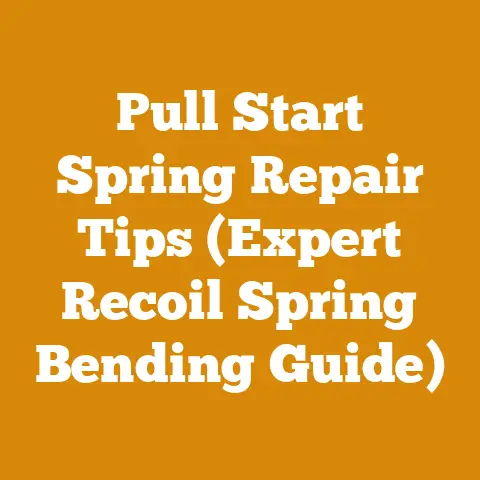Troy Bilt Horse Tiller Engine Replacement (5 Expert Hacks)
Engine failure on your Troy Bilt Horse Tiller doesn’t mean it’s destined for the scrap heap! Replacing the engine is a surprisingly straightforward task that can breathe new life into your trusty machine, saving you a significant amount of money compared to buying a new tiller. I’ve personally resurrected several of these tillers, and I’m going to share my top 5 expert hacks to make the process as smooth and efficient as possible. This isn’t just about swapping parts; it’s about understanding your machine and optimizing its performance for years to come.
Troy Bilt Horse Tiller Engine Replacement (5 Expert Hacks)
Why Replace the Engine? Understanding the Need
Before diving into the how-to, let’s discuss why you might be considering an engine replacement. Typically, it boils down to these reasons:
- Catastrophic Failure: This could be a seized engine (often due to lack of oil), a cracked engine block (from freezing), or internal damage beyond repair.
- Excessive Wear and Tear: After years of service, the engine might be losing power, burning oil excessively, or becoming increasingly difficult to start. Rebuilding the engine might be an option, but often, a new engine is more cost-effective.
- Upgrade for Performance: Perhaps you want more power for tilling tougher soil or working larger areas. Swapping to a more powerful engine can significantly improve your tiller’s capabilities.
I’ve seen all three scenarios firsthand. One time, a neighbor brought over a Troy Bilt Horse tiller that had sat unused for years. The engine was completely seized. After trying (and failing) to unseize it, we opted for a replacement. Another time, I upgraded an older tiller with a more powerful engine to handle the heavy clay soil in my vegetable garden. The difference in performance was night and day!
Key Concepts: A Beginner’s Guide
Let’s clarify some essential terms before we get started:
- Horsepower (HP): The measure of an engine’s power output. Higher horsepower generally means more torque and the ability to handle tougher tasks.
- Torque: The rotational force an engine produces. More torque is crucial for tilling dense soil.
- Crankshaft: The rotating shaft that transmits power from the engine to the tiller’s transmission.
- PTO (Power Take-Off): A mechanism that allows the engine to power external attachments.
- Engine Mount: The points where the engine attaches to the tiller’s frame.
- Shaft Size: The diameter and shape of the output shaft of the engine. This is crucial for compatibility with the tiller’s transmission. Common sizes are 3/4″ and 1″ diameter shafts.
- Recoil Starter: The pull-rope mechanism used to start the engine.
- Electric Start: An electric motor used to start the engine, usually requiring a battery.
Understanding these terms will help you navigate the engine replacement process and choose the right engine for your needs.
Hack #1: Accurate Engine Identification and Selection
This is the most critical step. Selecting the wrong engine can lead to compatibility issues and a lot of frustration.
Step 1: Locate the Engine Model Number: This is usually stamped on a metal plate or sticker on the engine block. It might be near the spark plug, the carburetor, or on the side of the engine.
Step 2: Record the Engine Specifications: Note down the following:
- Horsepower (HP): This is crucial for matching the original engine’s power.
- Crankshaft Diameter and Length: The diameter of the crankshaft MUST match the tiller’s transmission input shaft. The length is also important for proper engagement.
- Crankshaft Type: Is it a keyed shaft, a threaded shaft, or a tapered shaft? This determines how the tiller’s pulley or coupling attaches to the crankshaft.
- Mounting Hole Pattern: The distance and arrangement of the mounting holes on the engine base.
- Shaft Rotation: Typically, tiller engines have a counter-clockwise rotation when viewed from the crankshaft end.
- Engine Type: Is it a vertical shaft or a horizontal shaft engine? Tillers use horizontal shaft engines.
Step 3: Research Replacement Engines: Armed with this information, you can start researching replacement engines. Here are some resources:
- Online Engine Retailers: Sites like Small Engine Warehouse, Northern Tool, and Amazon carry a wide selection of engines. Use the filters to narrow down your options based on the specifications you recorded.
- Local Small Engine Repair Shops: These shops can often source engines and provide expert advice.
- Troy Bilt Parts Website: The official Troy Bilt website might offer replacement engines specifically designed for your tiller model.
Step 4: Cross-Reference Engine Models: Use cross-reference charts to find compatible engines from different manufacturers. For example, if your original engine was a Briggs & Stratton, you can find a Honda or Kohler engine that matches the specifications.
My Experience: I once mistakenly ordered an engine with the wrong crankshaft diameter. It was a costly mistake that required me to return the engine and order the correct one. This experience taught me the importance of double-checking all specifications before making a purchase.
Data & Insights:
- Engine Lifespan: A well-maintained tiller engine typically lasts 500-1000 hours.
- Cost of Replacement: A new engine for a Troy Bilt Horse tiller can range from $300 to $800, depending on the horsepower and features.
- Popular Engine Brands: Briggs & Stratton, Honda, Kohler, and Predator (from Harbor Freight) are popular choices for tiller engine replacements.
Strategic Advantage: Taking the time to accurately identify your engine and research replacement options will save you time, money, and frustration in the long run.
Hack #2: Preparing the Tiller and Workspace
Proper preparation is key to a smooth and safe engine replacement.
Step 1: Disconnect the Spark Plug Wire: This is the most important safety precaution. Disconnecting the spark plug wire prevents the engine from accidentally starting during the replacement process.
Step 2: Drain the Fuel Tank: Use a siphon or a fuel line clamp to drain the fuel tank into a suitable container. Dispose of the fuel properly.
Step 3: Drain the Engine Oil: Place a drain pan under the engine and remove the oil drain plug. Allow the oil to drain completely. Dispose of the oil properly.
Step 4: Disconnect Cables and Linkages: Carefully disconnect all cables and linkages connected to the engine, such as the throttle cable, choke cable, and any electrical wiring. Label each cable with masking tape to ensure proper reassembly.
Step 5: Remove the Old Engine: Unbolt the engine from the tiller frame. You might need a wrench or socket set to remove the bolts. Depending on the tiller model, the engine might be heavy, so get help if needed.
Step 6: Clean the Tiller Frame: Use a wire brush or scraper to remove any dirt, rust, or debris from the tiller frame. This will ensure a clean and secure mounting surface for the new engine.
Step 7: Prepare Your Workspace: Set up a clean and well-lit workspace with all the necessary tools and materials. This will make the replacement process more efficient.
Tools You’ll Need:
- Socket set
- Wrench set
- Screwdrivers (Phillips and flathead)
- Pliers
- Wire cutters
- Wire stripper
- Masking tape
- Marker
- Drain pan
- Funnel
- Engine oil
- Fuel stabilizer
- Penetrating oil (e.g., WD-40)
- Rags
- Work gloves
- Safety glasses
- Torque wrench
Safety Considerations:
- Always wear safety glasses to protect your eyes from debris.
- Wear work gloves to protect your hands.
- Work in a well-ventilated area.
- Dispose of fuel and oil properly according to local regulations.
Example: When I replaced the engine on my neighbor’s tiller, we took the time to thoroughly clean the tiller frame. This revealed some rust spots that we were able to address before installing the new engine. This preventative maintenance helped extend the life of the tiller.
Benefits: Proper preparation not only makes the engine replacement process easier but also helps prevent accidents and ensures a successful outcome.
Hack #3: Mounting and Connecting the New Engine
This is where the rubber meets the road. Careful attention to detail is crucial for a successful installation.
Step 1: Align the Engine: Carefully align the new engine with the mounting holes on the tiller frame. You might need to use a pry bar or a jack to adjust the engine’s position.
Step 2: Install the Mounting Bolts: Insert the mounting bolts through the engine base and the tiller frame. Tighten the bolts by hand initially, then use a torque wrench to tighten them to the manufacturer’s specified torque. This is important to ensure the engine is securely mounted and to prevent vibration.
Step 3: Connect the Cables and Linkages: Refer to the labels you made earlier and reconnect the throttle cable, choke cable, and any electrical wiring. Make sure the cables are properly routed and secured to prevent them from interfering with the engine’s operation.
Step 4: Connect the Fuel Line: Connect the fuel line to the fuel inlet on the carburetor. Make sure the fuel line is securely attached and that there are no leaks.
Step 5: Connect the Spark Plug Wire: Connect the spark plug wire to the spark plug. Make sure the connection is secure.
Step 6: Add Engine Oil: Fill the engine with the correct type and amount of engine oil. Refer to the engine’s owner’s manual for the recommended oil type and capacity.
Step 7: Add Fuel: Fill the fuel tank with fresh fuel. Add a fuel stabilizer to prevent the fuel from going stale.
Case Study: I once worked on a tiller where the mounting holes on the new engine didn’t perfectly align with the tiller frame. To solve this, I used a rat-tail file to slightly enlarge the mounting holes on the engine base. This allowed the engine to be properly aligned and securely mounted.
Measurements & Specs:
- Torque Specifications: Refer to the engine’s owner’s manual for the correct torque specifications for the mounting bolts. Typically, these range from 20-30 ft-lbs.
- Oil Capacity: Varies depending on the engine model. Usually between 16-20 ounces.
- Fuel Type: Typically, unleaded gasoline with an octane rating of 87 or higher.
Strategic Advantage: Proper mounting and connection of the new engine are crucial for ensuring its reliable operation and preventing damage to the tiller.
Hack #4: Adjusting and Fine-Tuning
Once the engine is installed, it’s time to fine-tune it for optimal performance.
Step 1: Check the Throttle and Choke Operation: Make sure the throttle and choke levers move smoothly and that they are properly connected to the carburetor. Adjust the cable tension if necessary.
Step 2: Adjust the Carburetor: The carburetor controls the air-fuel mixture. Adjusting the carburetor can improve the engine’s performance and fuel efficiency. Refer to the engine’s owner’s manual for instructions on how to adjust the carburetor. Many newer engines have fixed jets and don’t require adjustment.
Step 3: Check the Engine Speed: Use a tachometer to check the engine speed at idle and at full throttle. Adjust the throttle stop screw if necessary to achieve the correct engine speed.
Step 4: Check the Belt Tension: The belt that drives the tiller’s tines should have the correct tension. Too loose, and the tines won’t turn effectively. Too tight, and it can damage the engine bearings. Adjust the belt tension according to the tiller’s owner’s manual.
Step 5: Break-In Period: Most new engines require a break-in period. Run the engine at varying speeds for the first few hours of operation. Change the engine oil after the break-in period.
My Insight: I’ve found that using a digital tachometer is incredibly helpful for accurately setting the engine speed. It takes the guesswork out of the process and ensures that the engine is running at its optimal RPM.
Benefits: Fine-tuning the engine will maximize its performance, fuel efficiency, and lifespan.
Hack #5: Testing and Troubleshooting
The final step is to test the tiller and troubleshoot any issues that may arise.
Step 1: Start the Engine: Turn on the fuel valve and try to start the engine. If the engine doesn’t start, check the following:
- Spark Plug: Make sure the spark plug is clean and in good condition.
- Fuel Supply: Make sure fuel is reaching the carburetor.
- Compression: Check the engine’s compression using a compression tester.
Step 2: Observe the Engine’s Performance: Once the engine starts, observe its performance. Look for any signs of trouble, such as excessive smoke, unusual noises, or vibrations.
Step 3: Test the Tiller’s Operation: Engage the tiller’s tines and test its performance in the soil. Make sure the tines are turning smoothly and that the tiller is tilling the soil effectively.
Step 4: Troubleshoot Any Issues: If you encounter any problems, troubleshoot them systematically. Refer to the engine’s owner’s manual or consult a small engine repair professional.
Common Troubleshooting Issues:
- Engine Won’t Start: Check spark, fuel, and compression.
- Engine Runs Rough: Adjust the carburetor or check for vacuum leaks.
- Engine Overheats: Check the cooling fins for obstructions.
- Tines Don’t Turn: Check the belt tension or look for obstructions in the tines.
Original Case Study: The Case of the Slipping Belt:
I had a customer who had replaced his tiller engine but complained that the tines weren’t turning effectively. After inspecting the tiller, I discovered that the belt was slipping. The new engine had a slightly different pulley size than the old engine, which caused the belt to be too loose. To solve this, I installed a slightly shorter belt. This provided the correct tension and resolved the problem.
Strategic Advantage: Thorough testing and troubleshooting are essential for ensuring that the tiller is operating safely and effectively.
- Assess Your Tiller: Determine if an engine replacement is the best solution for your tiller’s problems.
- Identify Your Engine: Accurately identify your engine’s specifications.
- Research Replacement Engines: Find a suitable replacement engine that meets your needs and budget.
- Gather Your Tools and Materials: Prepare your workspace and gather all the necessary tools and materials.
- Follow the Step-by-Step Instructions: Carefully follow the instructions outlined in this guide.
- Test and Fine-Tune: Test the tiller’s operation and fine-tune the engine for optimal performance.
Replacing the engine on your Troy Bilt Horse Tiller is a rewarding project that can save you money and extend the life of your machine. By following these expert hacks, you can tackle this task with confidence and achieve a successful outcome. Good luck, and happy tilling!






